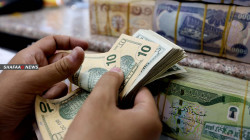World military spending rises to almost $2 trillion in 2020

Shafaq News/ Total global military expenditure rose to $1981 billion last year, an increase of 2.6 per cent in real terms from 2019, according to new data published today by the Stockholm International Peace Research Institute (SIPRI).
The five biggest spenders in 2020, which together accounted for 62 per cent of global military expenditure, were the United States, China, India, Russia and the United Kingdom. Military spending by China grew for the 26th consecutive year.
The 2.6 per cent increase in world military spending came in a year when global gross domestic product (GDP) shrank by 4.4 per cent (October 2020 projection by the International Monetary Fund), largely due to the economic impacts of the Covid-19 pandemic. As a result, military spending as a share of GDP—the military burden—reached a global average of 2.4 per cent in 2020, up from 2.2 per cent in 2019. This was the biggest year-on-year rise in the military burden since the global financial and economic crisis in 2009.
Even though military spending rose globally, some countries explicitly reallocated part of their planned military spending to pandemic response, such as Chile and South Korea. Several others, including Brazil and Russia, spent considerably less than their initial military budgets for 2020.
In 2020 US military expenditure reached an estimated $778 billion, representing an increase of 4.4 per cent over 2019. As the world’s largest military spender, the USA accounted for 39 per cent of total military expenditure in 2020. This was the third consecutive year of growth in US military spending, following seven years of continuous reductions.
China’s military expenditure, the second highest in the world, is estimated to have totaled $252 billion in 2020. This represents an increase of 1.9 per cent over 2019 and 76 per cent over the decade 2011–20. China’s spending has risen for 26 consecutive years, the longest series of uninterrupted increases by any country in the SIPRI Military Expenditure Database.
Nearly all members of the North Atlantic Treaty Organization (NATO) saw their military burden rise in 2020. As a result, 12 NATO members spent 2 per cent or more of their GDP on their militaries, the Alliance’s guideline spending target, compared with 9 members in 2019. France, for example, the 8th biggest spender globally, passed the 2 per cent threshold for the first time since 2009.
Russia’s military expenditure increased by 2.5 per cent in 2020 to reach $61.7 billion, This was the second consecutive year of growth. Nevertheless, Russia’s actual military spending in 2020 was 6.6 per cent lower than its initial military budget, a larger shortfall than in previous years.
With a total of $59.2 billion, the UK became the fifth largest spender in 2020. The UK’s military spending was 2.9 per cent higher than in 2019, but 4.2 per cent lower than in 2011. Germany increased its spending by 5.2 per cent to $52.8 billion, making it the seventh largest spender in 2020. Germany’s military expenditure was 28 per cent higher than in 2011. Military spending across Europe rose by 4.0 per cent in 2020.
In addition to China, India ($72.9 billion), Japan ($49.1 billion), South Korea ($45.7 billion) and Australia ($27.5 billion) were the largest military spenders in the Asia and Oceania region. All four countries increased their military spending between 2019 and 2020 and over the decade 2011–20.
Military expenditure in sub-Saharan Africa increased by 3.4 per cent in 2020 to reach $18.5 billion, The biggest increases in spending were made by Chad (+31 per cent), Mali (+22 per cent), Mauritania (+23 per cent) and Nigeria (+29 per cent), all in the Sahel region, as well as Uganda (+46 per cent).
Military expenditure in South America fell by 2.1 per cent to $43.5 billion in 2020. The decrease was largely due to a 3.1 per cent drop in spending by Brazil, the sub region’s largest military spender.
Eight of the nine members of the Organization of the Petroleum Exporting Countries (OPEC) for which SIPRI has figures cut their military spending in 2020. Angola’s spending fell by 12 per cent, Saudi Arabia’s by 10 per cent, and Kuwait’s by 5.9 per cent. Non-OPEC oil exporter Bahrain also cut its spending by 9.8 per cent.
The countries with the biggest increases in military burden among the top 15 spenders in 2020 were Saudi Arabia (+0.6 percentage points), Russia (+0.5 percentage points), Israel (+0.4 percentage points) and the USA (+0.3 percentage points).
The combined military spending of the 11 Middle Eastern countries for which SIPRI has spending figures decreased by 6.5 per cent in 2020, to $143 billion.
As for the Arab world, SIPRI pointed out that military spending decreased in seven countries including Iraq (-8.3 percentage points), Algeria by (-3.4 percentage points), Kuwait (-5.9 percentage points), Lebanon (-59 percentage points), and Bahrain (- 9.8 percentage points) and increased in four other countries including Oman (+1.7 percentage points), Morocco (+29 percentage points), Egypt (+6.3 percentage points), and Jordan (+2.5 percentage points).
SIPRI’s Military Expenditure Database is based in part on adopted budgets rather than final spending during the year and is adjusted once final spending figures are available. These adjustments are then included in the next annual update of the SIPRI database. Because of the uncertainties regarding the economic impacts of the Covid-19 pandemic, the difference between the current estimated military expenditure figures for 2020 and the adjusted figures, which will be available in the database from next year, is likely to be larger than in previous years.





